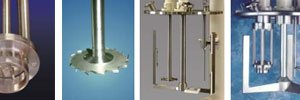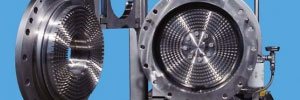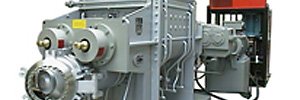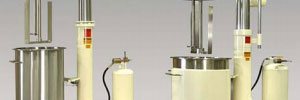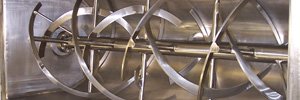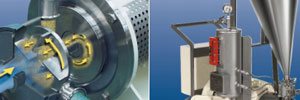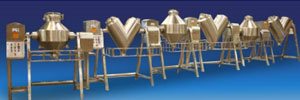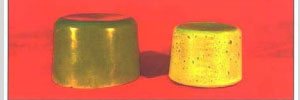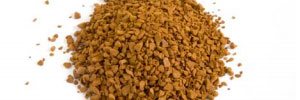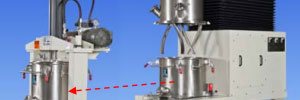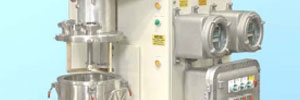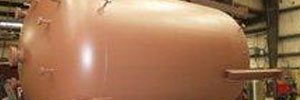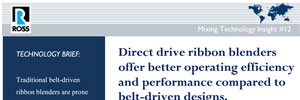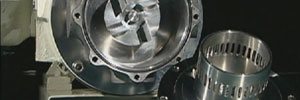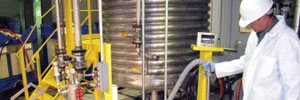Inks, Paints, and Coatings
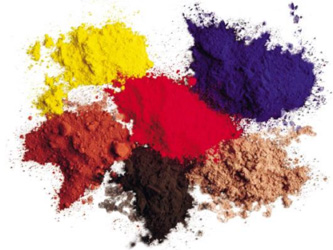
Regulatory requirements in the past few of decades have prompted the coatings industry to move its focus from conventional low-solid, solvent-based formulations to waterborne systems, high-solids coatings, energy-curable inks and other low-VOC technologies. This important environmentally-responsible shift coincided with exciting developments of new functionalities as a response to changing customer needs. Now faced with a growing demand for specialty and high value-added coatings, manufacturers are taking a closer look at their processing methods, particularly the mixing and milling steps. The question “What can we do better?” is asked more earnestly as coatings producers strive to improve performance and compliance while managing costs.
Various dispersion tools are employed in the production of paints, inks and coatings. Some of these technologies are relatively new solutions to age-old processing issues. Mixer selection is based on a number of factors including viscosity profile, shear requirement, order of addition and throughput.
ROSS High Speed Dispersers, High Shear Mixers, Three Roll Mills, and Multi-Shaft Mixers are widely used for various applications throughout this industry.
- Artist Colors - high solids pigment oil-based paints.
- Electronic Coatings - Electronic circuitry and devices require protective materials to shield it from the elements. Whether of low or high viscosity, an intermediate or the final coating, there is a ROSS Mixer suitable for this application.
- Fumed Silica Dispersions - Manufacturers of paints and coatings benefit from purchasing fumed silica in powder form and preparing the dispersions themselves than ordering silica dispersions for which they absorb higher shipping costs. Depending on the maximum viscosity and final grind, various ROSS Mixing Equipment allow manufactures to create these dispersions in-house.
- Inkjets - in the inkjet industry, the move away from dye-based inks towards pigments-based inks to deliver products of greater resistance to weathering and exposure to moisture, have also demanded mixing equipment that efficiently grinds pigments with reduced or no downstream milling necessary. Various ROSS high shear mixing devices, including the PreMax, have dramatically improved the production of inks for inkjet printers.
- Lithographic Pastes - high-viscosity pastes composed of oleoresin varnish filled with carbon black are prepared on ROSS Double Planetary Mixer and a Discharge System, economical alternative equipment to sigma blade mixers. Recent developments in mixing equipment and coatings formulations have shown that an investment in high viscosity vacuum premixing can return a larger dividend in productivity than a comparative investment in downstream milling.
- Paints - Various ROSS Mixers are used to disperse pigments and extenders used in paint including Titanium Dioxide (TiO2), Calcium Carbonate (CaCO3), Clay, Talc, Silica, Mica, and other coloring or plastic pigments into either water, oil or solvent, along with modifiers and additives.
- Silicone Coatings - silicon-based substances are used to create coatings and encapsulants for electronics, automobiles, aerospace, medical devices, etc.
- Specialty Inks - metallic/conductive, fluorescent, security, phosphorescent, and others.
- Standard Printing Inks - web offset ink, sheet-fed ink, soybean-based ink, rubber-based ink, water-based ink, UV ink, laser ink, process ink for color printing, and others.
- Steel Activators - coatings applied to steel prior to plating.
- Recommended Mixing Equipment for Filter Cake Dispersions
This bulletin describes three mixing technologies commonly utilized in the preparation of filter cake slurries: High Viscosity Dispersers, Dual-Shaft Mixers and Inline High Shear Mixers. - Recommended Mixing Equipment for Aluminum Hydroxide
Aluminum hydroxide, also called alumina trihydrate, hydrated alumina or ATH, is a fire-retardant filler added to various types of polymers to provide flame resistance and smoke suppression in plastics and composites. - Recommended Mixing Equipment for Gel Coats
Gel coats (or gelcoats) are modified resins applied to molds in the manufacture of fiber-reinforced plastics. - Recommended Mixing Equipment for High Viscosity Coatings
Depending on their method of application and intended use, certain coatings are produced as high viscosity fluids. Controlling rheology is one way of achieving desired coating performance in terms of sag and spatter resistance, flow leveling, gloss, film formation and other attributes. - Recommended Mixing Equipment for Specialty Inks
Specialty inks have become a staple in modern packaging, lending added appeal, security and functionality to products in ways that traditional inks could not achieve. - Recommended Mixing Equipment for Concentrated Titanium Dioxide Dispersions
Mixing titanium dioxide powders into liquid, especially in large quantities, requires sufficient shear in order to achieve optimal functionality. - Recommended Mixing Equipment for Pigment Dispersions
The costly and time-consuming milling step is often a production bottleneck which in the past has forced manufacturers to add more milling equipment to handle multiple passes or simply keep up with volume demands. - Recommended Mixing Equipment for Carbon Black Dispersions
Used in paints, inks, coatings, adhesives, sealants, plastics, electronics and specialty products, carbon black dispersions are typically prepared using high shear mixing or milling equipment to effectively break down agglomerates. - Rethink your reactor design.
Chemical processes accomplished in conventional stirred tank reactors can be optimized by switching to a multiagitator system capable of high speed dispersion or dissolution, as well as superior heat transfer and efficient turnover even at elevated viscosities. - Eliminate floating powders
Consider high-speed subsurface powder injection to eliminate floating powders and stubborn lumps in your mixing operation. Technologies such as the ROSS Solids/Liquid Injection Manifold (SLIM) are highly efficient at maximizing yield as a result of faster and more complete solid dispersion. - Ultra-high shear mixing of
nanoparticles
Batch and inline ultra-high shear rotor/stator mixers can effectively disperse nanoparticles into liquid. Advantages include short processing times and volume flexibility, as well as easier maintenance and lower capital cost compared to traditional milling equipment and high pressure homogenizers. - Dust-free mixing of pigments
into liquid
A common issue in dispersing pigments into liquid is dust generation. Charging solids into an open, top-agitated vessel inherently causes lightweight powders to become airborne. Using a high shear mixer equipped for sub-surface powder induction helps minimize dusting, maximize yield, improve dispersion quality and accelerate production. - Mixing highly filled compounds
Obtaining a good dispersion of fillers into a mixture is critical to end product quality. Highly filled, viscous compounds can be successfully prepared in multi-shaft or planetary mixers. - Tips to improve your batch
rotor/stator mixing process
The rotor/stator mixer is a versatile processing tool used throughout the process industries. This bulletin presents some tips for improving rotor/stator mixing performance. - Move your media mill process
to an ultra-high shear mixer.
Specially designed rotor/stator mixers achieve ultra-high shear conditions which often result in extremely fine dispersions of pigments and other raw materials. More than just an ordinary ‘pre-mixer’, an ultra-high shear rotor/stator device can produce results comparable to one or two passes through a media mill. - Best practices for safe and efficient three roll milling
The three roll mill remains to be one of the best methods for preparing very fine particle dispersions. This bulletin discusses some best practices to help users operate the three roll mill safely and efficiently. - Maximize pigment dispersion
efficiency during pre-mixing
Processing of pigments can be optimized by choosing an efficient pre-mixer that can disperse agglomerates as close as possible to the desired specifications. This leads to a reduction of mill passes, often the most time-consuming step of the pigment dispersion process. In some applications, specially designed rotor/stator pre-mixers can eliminate milling entirely. - High speed mixing: saw-tooth dispersers vs. rotor/stator mixers
The saw-tooth disperser and rotor/stator mixer are two of the most widely used high speed mixers yet many are unaware of the differences in their utility and operating capacities. Knowing the unique attributes of these devices is important in mixer selection and process optimization. - Run your rotor/stator mixer at maximum speed to optimize particle size reduction.
Generally, the maximum speed setting of a rotor/stator mixer provides the optimal mixing results in terms of particle or droplet size reduction. Once an equilibrium size distribution is reached, subsequent passes through the rotor/stator give diminishing returns. For applications that are processed at the maximum speed of a traditional rotor/stator mixer but still fall short of the desired particle or droplet size, a move to higher energy devices, such as ultra-high shear mixers, is recommended. - Eductor-less solids induction systems offer improved processing reliability
In traditional eductor-based powder induction systems, balancing the performance of the main components -- pump, eductor and mixer – often requires a skilled operator and can prove to be difficult. A high speed powder injection unit utilizing just one device to perform all three functions is simpler to use and offers a more reliable performance.

